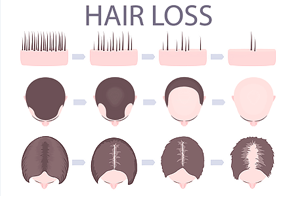
Thinning Hair: Why it Happens, How to Identify it, and How to Treat it
Hair thinning can affect anyone regardless of age, gender, genetics, etc. Here we try to explain WHY it happens, HOW to identify if your hair is thinning, and most importantly HOW to treat it.
Why it Happens:
There are many reasons for why hair thinning may arise. It may be temporary, it may be inevitable, it may lead to balding. Causes can include external factors such as medication, stress causing increased cortisol levels, frequent hairstyles that pull hair tightly, or internal factors such as genetics, hormonal changes, or recent pregnancy. Overall it affects ⅓ of all females, and ¼ of all males.
How to identify:
In order to address hair thinning, it’s important to identify if you’re experiencing it and what the causes are. Indicators include a widening hair part, more visible scalp, hairs on your pillow, and or thinner ponytail. Normal hair loss is highly individual meaning most people have a sense of how much hair is normal for them to lose. If you suddenly notice more hair than usual falling out, you’re shedding clumps of hair, or your hair seems to be visibly thinning it may be a sign that something is amiss. When combining the understanding of why it happens and how to identify if you are thinning, it can then be addressed more accurately. For example, if you’re experiencing a more visible scalp while going through a stressful situation for a long period of time, the two are likely connected.
Treatments:
Treatment can be separated in essentially two different categories.
Cosmetic treatment and the actual Thinning treatment. Cosmetic treatment can really be anything from a surgical hair transplant to using root lifters and color fiber sprays that grab onto existing hair follicles making it look more dense. Cosmetic treatments simply reduce the appearance of thinning hair however does not address the cause.
When it comes to thinning treatments it’s important to set the expectations. Men and women experience hair loss differently with females typically experiencing a widening hair part and men experiencing receding hairline and balding at the crown.

Most of the over the counter solutions are limited to postponing the onset of hair thinning and slowing the rate at which your hair is thinning however, as for actual regrowth (unless it is minoxidil) it likely is not viable. Supplements, stress management, and Minoxidil are still good options but they have their limits. For more intensive treatments to stop hair loss and even regrow hair, it is best to consult with a licensed dermatologist.
Overall, there are many causes of hair loss that can be treated successfully by delaying the onset of it, preserving your existing hair, and possibly regrowing it in certain areas however, the key to effective treatment is to find out what’s causing it. Without an accurate determination, treatment is often ineffective. Consider going to a dermatologist if you’ve struggled with thinning and hair loss repeatedly or if you want to ensure the best plan of action moving forward.

Leave a comment